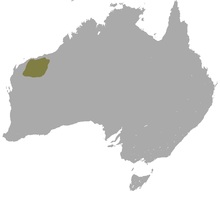Rothschild rock kangaroo
| Rothschild rock kangaroo | ||||||||||||
|---|---|---|---|---|---|---|---|---|---|---|---|---|
| Systematics | ||||||||||||
|
||||||||||||
| Scientific name | ||||||||||||
| Petrogale rothschildi | ||||||||||||
| Thomas , 1904 |
The Rothschild rock kangaroo ( Petrogale rothschildi ) is a species of marsupial from the kangaroo family (Macropodidae).
features
Rothschild rock kangaroos are among the larger representatives of the rock kangaroos . The males weigh an average of 6.1 kilograms, while the females weigh 4.1 kilograms. The fur of these animals is gray-brown on the back, the belly is whitish-gray. The neck and shoulders are colored light gray, sometimes this region turns purple. The rear part of the long tail is black, unlike many other rock kangaroos, there are no stripes on the face or on the flanks. As with most kangaroos, the hind legs are long and sturdy and the front legs are shorter.
distribution and habitat
These kangaroos live in Australia , their range is the Pilbara region in the north of Western Australia including offshore islands of the Dampier archipelago . Their habitat are rocky areas overgrown with prickly head grasses or eucalyptus .
Way of life
Rothschild rock kangaroos are nocturnal, they spend the day in caves or crevices. At night they go in search of food, mainly eating grass and herbs. Like all kangaroos, they have a multi-chambered stomach for better utilization of the difficult to digest plant food. They live in groups that usually consist of a few animals, but sometimes up to 100 individuals. The social behavior has not been researched in detail, presumably, as with other kangaroos, these are rather loose associations without permanent structures.
After around 30 days of gestation, the female gives birth to a single young. This spends its first six to seven months of life in its mother's pouch and is weaned at just under one year.
Danger
The main threat to the Rothschild rock kangaroo is stalking by introduced foxes , which has made it rare in parts of its range. The foxes do not stay in the higher areas where these kangaroos live, and on some islands the fox populations have been drastically restricted to ensure the survival of this species and other native animals. The species occurs in the Karijini National Park . According to the IUCN , it is not at risk.
literature
- Ronald Nowak: Walker's Mammals of the World. Johns Hopkins University Press, Baltimore 1999, ISBN 0-8018-5789-9
Web links
- Information and illustration
- Petrogale rothschildi onthe IUCN Red List of Threatened Species . Retrieved May 27, 2009.
